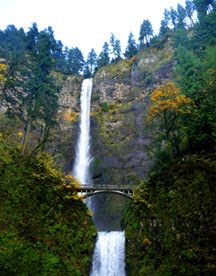 If you're like me and thousands of others, while driving on I-84 you struggle to catch a glimpse of Multnomah Falls, a well-known icon of Oregon and the Columbia River Gorge. Next time. Stop. Exit the freeway, park in the lot, take in the view, snap some photos and explore the scenery. You'll be glad you did.
If you're like me and thousands of others, while driving on I-84 you struggle to catch a glimpse of Multnomah Falls, a well-known icon of Oregon and the Columbia River Gorge. Next time. Stop. Exit the freeway, park in the lot, take in the view, snap some photos and explore the scenery. You'll be glad you did.The falls is split between the upper falls and lower falls. The total drop of the falls is about 620 feet making Multnomah Falls the tallest in Oregon. Cliff walls reveal the local geology exposed by floods.
As you might expect, higher volumes of water happen in winter and spring. Larch Mountain's underground springs are the continual source of the falls.
Hike up the 1.2 mile trail to the top of the falls and you'll be treated to beautiful views of Multnomah Falls and the Columbia River Gorge. From there you can continue hiking to the top of Larch Mountain or take the Wahkeena Loop Trail.
If you're lucky enough to live in the Northwest or able to visit often, visit Multnomah Falls at various times of year. Winter-Ice, Spring-Runoff, Summer-Refreshing, Fall-Colors. Next time you're driving the Columbia River Gorge, plan ahead, allow some time to stop.



